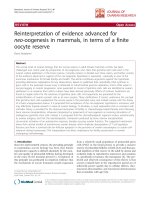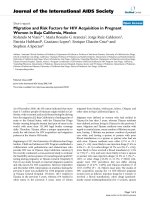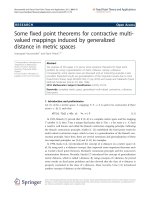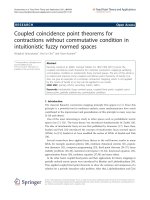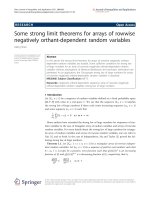Báo cáo hóa học: " Some Coincidence Point Theorems for Nonlinear Contraction in Ordered Metric Spaces" docx
Bạn đang xem bản rút gọn của tài liệu. Xem và tải ngay bản đầy đủ của tài liệu tại đây (326.86 KB, 15 trang )
RESEARC H Open Access
Some Coincidence Point Theorems for Nonlinear
Contraction in Ordered Metric Spaces
Wasfi Shatanawi
*
, Zead Mustafa and Nedal Tahat
* Correspondence:
Department of Mathematics,
Hashemite University, Zarqa 13115,
Jordan
Abstract
We establish new coincidence point theorems for nonlinear contraction in ordered
metric spaces. Also, we introduce an example to support our results. Some
applications of our obtained results are given.
MSC: 54H25; 47H10; 54E50; 34B15.
Keywords: ordered metric spaces, nonlinear contraction, fixed point, coincidence
point, coincidence fixed point, partially ordered set, altering distance function
1. Introduction and Preliminaries
Generalization of the Banach principle [1] has been heavily investigated by many
authors (see [2-14]). I n particular, there has been a number of fixed point theorems
involving altering distance functions. Such functions were introduced by Khan et al.
[15].
Definition 1.1. [15]The function j : [0, +∞) ® [0, +∞) is called an altering distance
function if the following properties are satisfied:
(1) j is continuous and nondecreasing.
(2) j(t)=0if and only if t =0.
Khan et al. [15] proved the following theorem.
Theorem 1.1. Let (X, d) be a co mplete metric space, ψ an altering distance function
and T : X ® X satisfying
ψ
(
d
(
Tx, Ty
))
≤ cψ
(
d
(
x, y
))
for x, y Î X and 0 <c<1. Then, T has a unique fixed point.
Existence of fixed point in partially ordered sets has been considered by many
aut hors. Ran and Reurings [14] studied a fixed point theo rem in partially ordered sets
and applied their result to matrix equations. While Nieto and Rodŕiguez-López [9] stu-
died some contractive mapping theorems in partially ordered set and applied their
main theorems to obtain a unique solution for a first order ordinary differential equa-
tion. For more works in partially ordered metric spaces, we refer the reader to [16-31].
Harjani and Sadarangani [7,8] obtained some fixed point theore ms in a complete
ordered metric space using altering dista nce functions. They proved the following
theorems.
Shatanawi et al. Fixed Point Theory and Applications 2011, 2011:68
/>© 2011 Shatanawi et al; licensee Springer. This is an Open Access article distribu ted under the terms of the Creative Commons
Attribution License (http://cre ativecommons.org/licenses/by/2.0), which permits unrestrict ed use, distribu tion, and reproduction in
any medium, provided the original work is properly cited.
Theorem 1.2.[8]Let (X, ≼) be a partially ordered set and suppose that there exists a
metric d in X such that (X, d) is a complete metric space. Let f : X ® X be a continuous
and nondecreasing mapping such that
ψ
(
d
(
fx, fy
))
≤ ψ
(
d
(
x, y
))
− φ
(
d
(
x, y
))
for comparable x, y Î X, where ψ and j are altering distance functions. If there exists
x
0
≼ f (x
0
), then f has a fixed point.
Theorem 1.3.[8]Let (X, ≼) be a partially ordered set and suppose that there exists a
metric d in X such that (X, d) is a complete metric space. Assume that X satisfies if (x
n
)
is a nondecreasing sequence in X such that x
n
® x, then x
n
≼ x for all n Î N.Letf: X
® X be a nondecreasing mapping such that
ψ
(
d
(
fx, fy
))
≤ ψ
(
d
(
x, y
))
− φ
(
d
(
x, y
))
for comparable x, y Î X, where ψ and j are altering distance functions. If there exists
x
0
≼ f (x
0
), then f has a fixed point.
Altun and Simsek [3] introduced the concept of weakly increasing mappings as
follows:
Definition 1.2.[3]Let (X, ≼) be a partially ordered set. Two mappings f, g : X ® X
are said to be weakly increasing if fx ≼ g(fx) and gx ≼ f(gx) for all x Î X.
Recently, Turkoglu [32] studied new common fixed point theorems for weakly com-
patible mappings on uniform spaces. While, Nashine and Samet [12] proved some new
coincidence point theorems for a pair of weakly increasing mappings. Very recently,
Shatanawi and Samet [33] proved some coincidence point theorems for a pair of
weakly increasing mappings with respect to another map.
The aim of this article is to study new coincidence point theo rems for a pair of
weakly decreasing mappings satisfying (ψ, j)-weakly contractive condition in an
ordered metric space (X, d), where j and ψ are altering distance functions.
2. Main Results
We start our study with the following definition:
Definition 2.1. Let (X, ≼) be a partially ordered set and T, f : X ® X be two mappings.
We say that f is weakly decreasing with respect to T if the following conditions hold:
(1) fX ⊆ TX.
(2) For all x Î X, we have fy ≼ fx for all y Î T
-1
(fx).
We need the following definition in our arguments.
Definition 2.2. [34]Let (X, d) be a metric space and f, g : X ® X. If w = fx = gx for
some x Î X, then x is called a coincidence point of f and g, and w is cal led a point of
coincidence of f and g. The pair {f, g} is said to be compatible if and only if
lim
n
→+∞
d(fgx
n
, gf x
n
)=
0
whenever (x
n
) is a sequence in X such that
lim
n
→+∞
fx
n
= lim
n
→+∞
gx
n
=
t
for some t Î X.
Shatanawi et al. Fixed Point Theory and Applications 2011, 2011:68
/>Page 2 of 15
Theorem 2.1. Let (X, ≼) be a partially ordered set and suppose that there exists a
metric d on X such that (X, d) is a c omplete metric space. Let T, f : X ® Xbetwo
maps such that for all x, y Î X with Tx and Ty are comparable, we have
ψ(d(fx, fy)) ≤ ψ
max
d(Tx, Ty), d(fx, Tx), d(fy, Ty),
1
2
(d(fx, Ty)+d(fy, Tx))
− φ
max
d(fx, fy), d(fx, Tx), d(fy, Ty),
1
2
(d(fx, Ty)+d(fy, Tx))
,
(1)
where j and ψ are altering distance functions. Assume that T and f satisfy the follow-
ing hypotheses:
(i) f is weakly decreasing with respect to T.
(ii) The pair {T, f} is compatible.
(iii) f and T are continuous.
Then, T and f have a coincidence point.
Proof. Let x
0
Î X. Since fX ⊆ TX, we choose x
1
Î X such that fx
0
= Tx
1
. Also, since
fX ⊆ TX, we choose x
2
Î X such that fx
1
= Tx
2
. Continuin g this proces s, we can con-
struct a sequences (x
n
)inX such that Tx
n+1
= fx
n
.Now,sincex
1
Î T
-1
(fx
0
)andx
2
Î
T
-1
( fx
1
), by using the assumption that f is weakly decreasing with respect to T,we
obtain
f
x
0
f
x
1
f
x
2
.
By induction on n, we conclude that
f
x
0
f
x
1
···
f
x
n
f
x
n+1
···
.
Hence,
Tx
1
Tx
2
··· Tx
n
Tx
n
+1
···
.
If
Tx
n
0
+1
= Tx
n
0
for some n
0
Î X,then
fx
n
0
= Tx
n
0
. Thus ,
x
n
0
is a coincidence point of
T and f. Hence, we may assume that Tx
n+1
≠ Tx
n
for all n Î N.
Since Tx
n
and Tx
n+1
are comparable, then by (1), we have
ψ(d(Tx
n+1
, Tx
n+2
))
= ψ(d(fx
n
, fx
n+1
))
≤ ψ
max
d(Tx
n
, Tx
n+1
), d(fx
n
, Tx
n
), d(fx
n+1
, Tx
n+1
),
1
2
(d(fx
n
, Tx
n+1
)+d(Tx
n
, fx
n+1
))
− φ
max
d(Tx
n
, Tx
n+1
), d(fx
n
, Tx
n
), d(fx
n+1
, Tx
n+1
),
1
2
(d(fx
n
, Tx
n+1
)+d(Tx
n
, fx
n+1
))
= ψ
max
d(Tx
n
, Tx
n+1
), d(Tx
n+2
, Tx
n+1
),
1
2
d(Tx
n
, Tx
n+2
)
− φ
max
d(Tx
n
, Tx
n+1
), d(Tx
n+1
, Tx
n+2
),
1
2
d(Tx
n
, Tx
n+2
)
≤ ψ
max
d(Tx
n
, Tx
n+1
), d(Tx
n+2
, Tx
n+1
),
1
2
d(Tx
n
, Tx
n+2
)
− φ(max{d(Tx
n
, Tx
n+1
), d(Tx
n+1
, Tx
n+2
)})
≤ ψ(max{d(Tx
n
, Tx
n+1
), d(Tx
n+1
, Tx
n+2
)})
− φ(max{d(Tx
n
, Tx
n+1
), d(Tx
n+1
, Tx
n+2
)})
≤ ψ
(
max{d
(
Tx
n
, Tx
n+1
)
, d
(
Tx
n+1
, Tx
n+2
)
}
)
.
Shatanawi et al. Fixed Point Theory and Applications 2011, 2011:68
/>Page 3 of 15
If
max{
d(
Tx
n
, Tx
n+1
)
,
d(
Tx
n+1
, Tx
n+2
)
} =
d(
Tx
n+1
, Tx
n+2
),
then
ψ
(
d
(
Tx
n+1
, Tx
n+2
)
≤ ψ
(
d
(
Tx
n+1
, Tx
n+2
))
− φ
(
d
(
Tx
n+1
, Tx
n+2
)).
So, j(d(Tx
n+1
, Tx
n+2
)) = 0 and hence d(Tx
n+1
, Tx
n+2
) = 0, a contradiction.
Thus,
max{d
(
Tx
n
, Tx
n+1
)
, d
(
Tx
n+1
, Tx
n+2
)
} = d
(
Tx
n
, Tx
n+1
).
Therefore, we have
ψ
(
d
(
Tx
n+1
, Tx
n+2
))
≤ ψ
(
d
(
Tx
n
, Tx
n+1
))
− φ
(
d
(
Tx
n
, Tx
n+1
))
≤ ψ
(
d
(
Tx
n
, Tx
n+1
)).
(2)
Since ψ is a nondecreasing f unction, we get that {d(Tx
n+1
, Tx
n
): n Î N} is a nonin-
creasing sequence. Hence, there is r ≥ 0 such that
lim
n
→+
∞
d(Tx
n
, Tx
n+1
)=r
.
Letting n ® +∞ in (2) and using the continuity of ψ and j, we get that
ψ
(
r
)
≤ ψ
(
r
)
− φ
(
r
).
Thus, j(r) = 0 and hence r = 0. Therefore,
lim
n
→+
∞
d(Tx
n
, Tx
n+1
)=0
.
(3)
Now, we prove that (Tx
n
) is a Cauchy sequence in X. Suppose to the contrary; that
is, (Tx
n
) is not a Cauchy sequence. Then, there exists ε >0 for which we can find two
subsequences of positive integers (Tx
m(i)
)and(Tx
n(i)
) such that n(i) is the smallest
index for which
n(i) > m(i) > i, d(Tx
m
(
i
)
, Tx
n
(
i
)
) ≥ ε
.
(4)
This means that
d(Tx
m
(
i
)
, Tx
n
(
i
)
−1
) <ε
.
(5)
From (4), (5) and the triangular inequality, we have
ε ≤ d(Tx
m(i)
, Tx
n(i)
)
≤ d(Tx
m(i)
, Tx
n(i)−1
)+d(Tx
n(i)−1
, Tx
n(i)
)
<ε+ d(Tx
n
(
i
)
−1
, Tx
n
(
i
)
).
On letting i ® +∞ in above inequality and using (3), we have
lim
i
→+∞
d(Tx
m(i)
, Tx
n(i)
) = lim
i
→+∞
d(Tx
m(i)
, Tx
n(i)−1
)=ε
.
(6)
Shatanawi et al. Fixed Point Theory and Applications 2011, 2011:68
/>Page 4 of 15
Also,
ε ≤ d(Tx
n(i)
, Tx
m(i)
)
≤ d(Tx
n(i)
, Tx
m(i)+1
)+d(Tx
m(i)+1
, Tx
m(i)
)
≤ d(Tx
n(i)
, Tx
n(i)−1
)+d(Tx
n(i)−1
, Tx
m(i)+1
)+d(Tx
m(i)+1
, Tx
m(i)
)
≤ d(Tx
n(i)
, Tx
n(i)−1
)+d(Tx
n(i)−1
, Tx
m(i)
)+2d(Tx
m(i)+1
, Tx
m(i)
)
≤ d(Tx
n
(
i
)
, Tx
n
(
i
)
−1
)+ε +2d(Tx
m
(
i
)
+1
, Tx
m
(
i
)
).
Letting i ® +∞ in the above inequalities and using (3), we get that
lim
i
→+
∞
d(Tx
n(i)−1
, Tx
m(i)+1
) = lim
i
→+
∞
d(Tx
n(i)
, Tx
m(i)+1
)=ε
.
(7)
Since Tx
n(i)-1
and Tx
m(i)
are comparable, by (1), we have
ψ(d(Tx
n(i)
, Tx
m(i)+1
))
= ψ(d(fx
n(i)−1
, fx
m(i)
)
≤ ψ
max
d(Tx
n(i)−1
, Tx
m(i)
), d(fx
n(i)−1
, Tx
n(i)−1
), d(fx
m(i)
, Tx
m(i)
),
1
2
(d(fx
n(i)−1
, Tx
m(i)
)+d(Tx
n(i)−1
, fx
m(i)
))
− φ
max
d(Tx
n(i)−1
, Tx
m(i)
), d(fx
n(i)−1
, Tx
n(i)−1
), d(fx
m(i)
, Tx
m(i)
),
1
2
(d(fx
n(i)−1
, Tx
m(i)
)+d(Tx
n(i)−1
, fx
m(i)
))
= ψ
max
d(Tx
n(i)−1
, Tx
m(i)
), d(Tx
n(i)
, Tx
n(i)−1
), d(Tx
m(i)+1
, Tx
m(i)
),
1
2
(d(Tx
n(i)
, Tx
m(i)
)+d(Tx
n(i)−1
, Tx
m(i)+1
))
− φ
max
d(Tx
n(i)−1
, Tx
m(i)
), d(Tx
n(i)
, Tx
n(i)−1
), d(Tx
m(i)+1
, Tx
m(i)
)
,
1
2
(d(Tx
n(i)
, Tx
m(i)
)+d(Tx
n(i)−1
, Tx
m(i)+1
))
.
Letting i ® +∞ in the above inequalities, and using (3), (6) and (7), we get that
ψ
(
ε
)
≤ ψ
(
ε
)
− φ
(
ε
).
Therefore, j(ε) = 0 and hence ε = 0, a contradiction. Thus, {Tx
n
} is a Cauchy
sequence in the complete metric space X. Therefore, there exists u Î X such that
lim
n
→+
∞
Tx
n
= u
.
By the continuity of T, we have
lim
n
→+
∞
T(Tx
n
)=Tu
.
Since Tx
n+1
= fx
n
® u, Tx
n
® u, and the pair {T, f} is compatible, we have
lim
n
→+∞
d(f (Tx
n
), T(fx
n
)) = 0
.
By the triangular inequality, we have
d
(
fu, Tu
)
≤ d
(
fu, f
(
Tx
n
))
+ d
(
f
(
Tx
n
)
, T
(
fx
n
))
+ d
(
T
(
fx
n
)
, Tu
).
Letting n ® +∞ and using the fact that T and f are continuous, we get that d(fu, Tu)
= 0. Hence, fu = Tu, that is, u is a coincidence point of T and f.
Shatanawi et al. Fixed Point Theory and Applications 2011, 2011:68
/>Page 5 of 15
Theorem 2.2. Let (X, ≼) be a partially ordered set and suppose that there exists a
metric d on X. Let T, f : X ® X be two maps such that for all x, y Î X with Tx and Ty
are comparable, we have
ψ(d(fx, fy)) ≤ ψ
max
d(Tx, Ty), d(fx, Tx), d(fy, Ty),
1
2
(d(fx, Ty)+d(fy, Tx))
− φ
max
d(fx, fy), d(fx, Tx), d(fy, Ty),
1
2
(d(fx, Ty)+d(fy, Tx))
,
(8)
where j and ψ are altering distance functions. Suppose that the following hypotheses
are satisfied:
(i) If (x
n
) is a nonincreasing sequence in X with respect to ≼ such that x
n
® x Î X
as n ® +∞, then x
n
≽ x for all n Î N.
(ii) f is weakly decreasing with respect to T.
(iii) TX is a complete subspace of X.
Then, T and f have a coincidence point.
Proof. Following the proof of Theorem 2.1, we have (Tx
n
) is a Cauchy sequence in
(TX, d). Since TX is complete, there is v Î X such that
lim
n
→+
∞
Tx
n
= Tv = u
.
Since {Tx
n
} is a nonincreasing sequence in X. By hypotheses, we have Tx
n
≽ Tv for
all n Î N. Thus, by (8), we have
ψ(d(Tx
n+1
, fv)) = ψ(fx
n
, fv)
≤ ψ
max
d(Tx
n
, Tv), d(fx
n
, Tx
n
), d(fv, Tv),
1
2
(d(fx
n
, Tv)+d(fv, Tx
n
))
− φ
max
d(Tx
n
, Tv), d(fx
n
, Tx
n
), d(fv, Tv),
1
2
(d(fx
n
, Tv)+d(fv, Tx
n
))
= ψ
max
d(Tx
n
, Tv), d(Tx
n+1
, Tx
n
), d(fv, Tv),
1
2
(d(Tx
n+1
, Tv)+d(fv, Tx
n
))
− φ
max
d(Tx
n
, Tv), d(Tx
n+1
, Tx
n
), d(fv, Tv),
1
2
(d(Tx
n+1
, Tv)+d(fv, Tx
n
))
.
Letting n ® +∞ in the above inequalities, we get that
ψ
(
d
(
Tv, fv
))
≤ ψ
(
d
(
Tv, fv
))
− φ
(
d
(
Tv, fv
)).
Hence, j(d(Tv, fv )) = 0. Since j is an altering distance function, we get that d(Tv, fv)
= 0. Therefore, Tv = fv. Thus, v is a coincidence point of T and f.
By taking ψ(t)=t and j(t) = (1 - k)t, k Î [0, 1) in Theorems 2.1 and 2.2, we have the
following two results.
Corollary 2.1. Let (X, ≼ ) be a part ially ordered set and suppose that there exists a
metric d on X such that (X, d) is a c omplete metric space. Let T, f : X ® Xbetwo
maps such that for all x, y Î X with Tx and Ty are comparable, we have
d(fx, fy) ≤ k max
d(Tx, Ty), d(fx, Tx), d(fy, Ty),
1
2
(d(fx, Ty)+d(fy, Tx))
.
Shatanawi et al. Fixed Point Theory and Applications 2011, 2011:68
/>Page 6 of 15
Assume that T and f satisfy the following hypotheses:
(i) f is weakly decreasing with respect to T.
(ii) The pair {T, f} is compatible.
(iii) f and T are continuous.
If k Î [0, 1), then T and f have a coincidence point.
Corollary 2.2. Let (X, ≼ ) be a part ially ordered set and suppose that there exists a
metric d on X. Let T, f : X ® X be two maps such that for all x, y Î X with Tx and Ty
are comparable, we have
d(fx, fy) ≤ k max
d(Tx, Ty), d(fx, Tx), d(fy, Ty),
1
2
(d(fx, Ty)+d(fy, Tx))
.
Suppose that the following hypotheses are satisfied:
(i) If (x
n
) is a nonincreasing sequence in X with respect to ≼ such that x
n
® x Î X
as n ® +∞, then x
n
≽ x for all n Î N.
(ii) f is weakly decreasing with respect to T.
(iii) TX is a complete subspace of X.
If k Î [0, 1), then T and f have a coincidence point.
Corollary 2.3. Let (X, ≼ ) be a part ially ordered set and suppose that there exists a
metric d on X such that (X, d) is a c omplete metric space. Let T, f : X ® Xbetwo
maps such that for all x, y Î X with Tx and Ty are comparable, we have
d(fx, fy) ≤ a
1
d(Tx, Ty)+a
2
d(fx, Tx)+a
3
d(fy, Ty )+
a
4
2
(d(fx, Ty)+d(fy, Tx))
.
Assume that T and f satisfy the following hypotheses:
(i) f is weakly decreasing with respect to T.
(ii) The pair {T, f} is compatible.
(iii) f and T are continuous.
If a
1
+ a
2
+ a
3
+ a
4
Î [0, 1), then T and f have a coincidence point.
Proof. Follows from Corollary 2.1 by noting that
a
1
d(Tx, Ty)+a
2
d(fx, Tx)+a
3
d(fy, Ty)+
a
4
2
(d(fx, Ty)+d(fy, Tx)
)
≤ (a
1
+ a
2
+ a
3
+ a
4
)max
d(Tx, Ty), d(fx, Tx), d(fy, Ty),
1
2
(d(fx, Ty)+d(fy, Tx))
.
□
Corollary 2.4. Let (X, ≼ ) be a part ially ordered set and suppose that there exists a
metric d on X such that (X, d) is a complete metric space. Let f : X ® X be a map such
that for all comparable x, y Î X, we have
Shatanawi et al. Fixed Point Theory and Applications 2011, 2011:68
/>Page 7 of 15
ψ(d(fx, fy)) ≤ ψ
max
d(x, y), d(fx, x), d(fy, y),
1
2
(d(fx, y)+d(fy, x))
− φ
max
d(x, y), d(fx, x), d(fy, y),
1
2
(d(fx, y)+d(fy, x))
,
where j and ψ are altering distance functions. Assume that f satisfies t he following
hypotheses:
(i) f(fx) ≼ fx for all x Î X.
(ii) f is continuous.
Then, f has a fixed point.
Proof. Follows from Theorem 2.1 by taking T = i
X
(the identity map).
Corollary 2.5. Let (X, ≼ ) be a part ially ordered set and suppose that there exists a
metricdonXsuchthat(X, d) is complete. Let f : X ® Xbeamapsuchthatforall
comparable x, y Î X, we have
ψ(d(fx, fy)) ≤ ψ
max
d(x, y), d(fx, x), d(fy, y),
1
2
(d(fx, y)+d(fy, x))
− φ
max
d(x, y), d(fx, x), d(fy, y),
1
2
(d(fx, y)+d(fy, x))
,
where j and ψ are altering distance functions. Suppose that the following hypotheses
are satisfied:
(i) If (x
n
) is a nonincreasing sequence in X with respect to ≼ such that x
n
® x Î X
as n ® +∞, then x
n
≽ x for all n Î N.
(ii) f(fx) ≼ fx for all x Î X.
Then, f has a fixed point.
Proof. Follows from Theorem 2.2 by taking T = i
X
(the identity map).
By taking ψ(t)=t and j(t)=(1-k)t, k Î [0, 1) in Corollaries 2.4 and 2.5, we have
the following results.
Corollary 2.6. Let (X, ≼ ) be a part ially ordered set and suppose that there exists a
metric d on X such that (X, d) is a complete metric space. Let f : X ® X be a map such
that for all comparable x, y Î X, we have
d(fx, fy) ≤ k max
d(x, y), d(fx, x), d(fy, y),
1
2
(d(fx, y)+d(fy, x))
.
Assume f satisfies the following hypotheses:
(i) f(fx) ≼ fx for all x Î X.
(ii) f is continuous.
If k Î [0, 1), then f has a fixed point.
Corollary 2.7. Let (X, ≼ ) be a part ially ordered set and suppose that there exists a
metricdonXsuchthat(X, d) is complete. Let f : X ® Xbeamapsuchthatforall
comparable x, y Î X, we have
Shatanawi et al. Fixed Point Theory and Applications 2011, 2011:68
/>Page 8 of 15
d(fx, fy) ≤ k max
d(x, y), d(fx, x), d(fy, y),
1
2
(d(fx, y)+d(fy, x))
.
Suppose that the following hypotheses are satisfied:
(i) If (x
n
) is a nonincreasing sequence in X with respect to ≼ such that x
n
® x Î X
as n ® +∞, then x
n
≽ x for all n Î N.
(ii) f(fx) ≼ fx for all x Î X.
If k Î [0, 1), then f has a fixed point.
Now, we introduce an example to support our results.
Example 2.1. Let X = [0, +∞). Define d : X × X ® ℝ by d(x, y)=|x - y|. Define f, T :
X ® Xby
f (x)=
1
16
x
4
,0≤ x ≤ 1
;
1
16
√
x
, x > 1
and
T(x)=
x
2
,0≤ x ≤ 1
;
x, x > 1.
Then,
(1) fX ⊆ TX.
(2) f and T are continuous.
(3) The pair {f, T} is compatible.
(4) f is weakly decreasing with respect to T.
(5) For all x, y Î X, we have
d(fx, fy) ≤
1
4
max
d(Tx, Ty),
1
2
(d(fx, Ty)+d(fy, Tx))
.
Proof. The proof of (1) and (2) is clear.
To prove (3), let (x
n
) be any sequence in X such that
lim
n
→+∞
fx
n
= lim
n
→+∞
Tx
n
=
t
for some t Î X.Since
0 ≤ fx
n
≤
1
1
6
,wehave
0 ≤ t ≤
1
1
6
.SinceTx
n
® t as n ® +∞,
we have (x
n
) has at most only finitely many elements greater than 1. Thus,
fx
n
=
1
1
6
x
4
n
and
Tx
n
= x
2
n
for all n Î N except at most for finitely many elements. Thus, we have
x
n
→ 2
4
√
t
and
x
n
→
√
t
as n ® +∞. By uniqueness of limit, we get that
√
t =2
4
√
t
and
hence t = 0. Thus, x
n
® 0asn ® +∞. Since f and T are continuous, we have fx
n
® f0
= 0 and Tx
n
® T0=0asn ® +∞. Therefore,
lim
n
→+∞
d(T(fx
n
), f (Tx
n
)) = d(T0, f0) = d(0, 0) = 0
.
Thus, the pair {f, T} is compatible.
To prove f is weakly decreasing with respect to T,letx, y Î X be such that y Î T
-1
(fx). If x Î [0, 1], then
Shatanawi et al. Fixed Point Theory and Applications 2011, 2011:68
/>Page 9 of 15
Ty =
1
16
x
4
∈
0,
1
16
.
In this case, we must have Ty = y
2
. Thus,
y
2
=
1
1
6
x
4
. Hence,
y =
1
4
x
2
. Therefore,
fy = f
1
4
x
2
=
1
16
1
4
x
2
4
≤
1
16
x
4
= fx
.
If x>1, then
fx =
1
16
√
x
∈
0,
1
16
. Thus,
Ty = fx ∈
0,
1
1
6
. In this case, we have Ty = y
2
.
Thus,
y
2
=
1
16
√
x
.
So,
y =
1
4
4
√
x
.
Therefore,
fy = f
1
4
4
√
x
=
1
16
1
256x
≤
1
16x
≤
1
16
√
x
= fx
.
Therefore, f is weakly decreasing with respect to T.
To prove (5), let x, y Î X.
Case 1: If x, y Î [0, 1], then
|
fx − fy| =
1
16
x
4
−
1
16
y
4
=
1
16
|x
2
+ y
2
||x
2
− y
2
|
≤
1
8
|Tx − Ty|
=
1
8
d(Tx, Ty)
≤
1
4
max
d(Tx, Ty),
1
2
(d(fx, Ty)+d(fy, Tx))
.
Case 2: If x, y Î (1, +∞), then
|
fx − fy| =
1
16
√
x
−
1
16
√
y
=
1
16
1
√
x
−
1
√
y
=
1
16
√
y −
√
x
√
x
√
y
=
1
16
y − x
√
x
√
y(
√
y +
√
x)
≤
1
32
|y − x|
=
1
32
d(Tx, Ty)
≤
1
4
max
d(Tx, Ty),
1
2
(d(fx, Ty)+d(fy, Tx))
.
Shatanawi et al. Fixed Point Theory and Applications 2011, 2011:68
/>Page 10 of 15
Case 3: (x Î [0, 1] and y Î (1, +∞)) or (y Î [0, 1] and x Î (1, +∞)).
Without loss of generality, we may assume that x Î [0, 1] and y Î (1, +∞). Then,
|
fx − fy| =
1
16
x
4
−
1
√
y
=
1
16
x
2
−
1
4
√
y
x
2
+
1
4
√
y
≤
1
8
x
2
−
1
4
√
y
.
If
1
4
√
y
≥ x
2
,
then
|
fx − fy|≤
1
8
1
4
√
y
− x
2
≤
1
8
(y −x
2
)
=
1
8
d(Ty, Tx)
≤
1
4
max
d(Tx, Ty),
1
2
(d(fx, Ty)+d(fy, Tx))
.
If
x
2
≥
1
4
√
y
,
then
|
fx − fy|≤
1
8
x
2
−
1
4
√
y
≤
1
8
x
2
−
1
16
4
√
y
≤
1
8
x
2
−
1
16
√
y
=
1
8
d(Tx, fy)
≤
1
4
1
2
(d(fx, Ty)+d(fy, Tx))
≤
1
4
max
d(Tx, Ty),
1
2
(d(fx, Ty)+d(fy, Tx))
.
Thus, f and T satisfy all the hypotheses of Corollary 2.1. Therefore, T and f have a
coincidence point. Here (0, 0) is the coincidence point of f and T.
3. Applications
Denote by Λ the set of functions l : [0, +∞) ® [0, +∞) satisfying the following hypoth-
eses:
Shatanawi et al. Fixed Point Theory and Applications 2011, 2011:68
/>Page 11 of 15
(1) l is a Lebesgue-integrable mapping on each compact of [0, +∞).
(2) For every ε >0, we have
ε
0
λ(s)ds > 0
.
It is an easy matter to see that the mapping ψ : [0, +∞) ® [0, + ∞) defined by
ψ(t)=
t
0
λ(s)d
s
is an altering distance function. Now, we have the following results:
Theorem 3.1. Let (X, ≼) be a partially ordered set and suppose that there exists a
metric d on X such that (X, d) is a c omplete metric space. Let T, f : X ® Xbetwo
maps such that for all x, y Î X with Tx and Ty are comparable, we have
d(fx,fy)
0
λ(s)ds ≤
max
d(Tx,Ty ),d(fx,Tx),d(fy,Ty ),
1
2
(d(fx,Ty )+d(fy,Tx))
0
λ(s)d
s
−
max
d(fx,fy),d(fx,Tx),d(fy,Ty ),
1
2
(d(fx,Ty )+d(fy,Tx))
0
μ(s)ds,
where l, μ Î Λ. Assume that T and f satisfy the following hypotheses:
(1) f is weakly decreasing with respect to T.
(2) The pair {T, f} is compatible.
(3) f and T are continuous.
Then, T and f have a coincidence point.
Proof. Follows from Theorem 2.1 by taking
ψ(t)=
t
0
λ(s)d
s
and
φ(t)=
t
0
μ(s)d
s
. □
Theorem 3.2. Let (X, ≼) be a partially ordered set and suppose that there exists a
metric d on X. Let T, f : X ® X be two maps such that for all x, y Î X with Tx and Ty
are comparable, we have
d(fx,fy)
0
λ(s)ds ≤
max
d(Tx,Ty ),d(fx,Tx),d(fy,Ty ),
1
2
(d(fx,Ty )+d(fy,Tx))
0
λ(s)d
s
−
max
d(fx,fy),d(fx,Tx),d(fy,Ty ),
1
2
(d(fx,Ty )+d(fy,Tx))
0
μ(s)ds,
where l, μ Î Λ. Suppose that the following hypotheses are satisfied:
(1) If (x
n
) is a nonincreasing sequence in X with respect to ≼ such that x
n
® x Î X
as n ® +∞, then x
n
≽ x for all n Î N.
(2) f is weakly decreasing with respect to T.
(3) TX is a complete subspace of X.
Then, T and f have a coincidence point.
Proof. Follows from Theorem 2.2 by taking
ψ(t)=
t
0
λ(s)d
s
and
φ(t)=
t
0
μ(s)d
s
. □
Now, our aim is to give an existence theorem for a solution of the following integral
equation:
Shatanawi et al. Fixed Point Theory and Applications 2011, 2011:68
/>Page 12 of 15
u
(t )=
T
0
K(t, s , u(s))ds + g(t), t ∈ [0, T]
,
(9)
where T>0. Let X = C([0, T]) be the set of all continuous functions defined on [0,
T]. Define
d :
X × X → R
+
by
d(x, y)= sup
t∈
[
0,T
]
|x(t) − y(t)|
.
Then, (X, d) is a complete metric space. Define an ordered relation ≤ on X by
x ≤ y iff x
(
t
)
≤ y
(
t
)
, ∀t ∈ [0, T]
.
Then, (X, ≤) is a partially ordered set. Now, we prove the following result.
Theorem 3.3. Suppose the following hypotheses hold:
(1) K : [0, T] × [0, T]×ℝ
+
® ℝ
+
and g : ℝ ® ℝ are continuous .
(2) For each t, s Î [0, T], we have
K(t, s ,
T
0
K(s, τ , u(τ ))dτ + g(s)) ≤ K(t, s, u(s))
.
(3) There exist a continuous function G : [0, T] × [0, T] ® [0, +∞] such that
|
K
(
t, s, u
)
− K
(
t, s, v
)
|≤G
(
t, s
)
|u − v
|
for each comparable u, v Î ℝ and each t, s Î [0, T].
(4)
sup
t∈
[
0,T
]
T
0
G(t , s)ds ≤
r
for some r <1.
Then, the integral equation (9) has a solution u Î C([0, T]).
Proof. Define f : C([0, T]) ® C([0, T]) by
fx(t )=
T
0
K(t, s , x(s))ds + g(t), t ∈ [0, T]
.
Now, we have
f (fx(t)) =
T
0
K(t, s , fx(s))ds + g(t)
=
T
0
K
t, s,
T
0
K(s, τ , x(τ ))dτ + g(s)
ds + g(t
)
≤
T
0
K(t, s , x(s))ds + g(t)
= fx
(
t
)
.
Thus, we have f(fx) ≤ fx for all x Î C([0, T]).
Shatanawi et al. Fixed Point Theory and Applications 2011, 2011:68
/>Page 13 of 15
For x, y Î C([0, T]) with x ≼ y, we have
d(fx, fy)= sup
t∈[0,T]
|fx(t) − fy(t)|
=sup
t∈[0,T]
T
0
K(t, s , x(s)) −K(t, s, y(s))ds
≤ sup
t∈[0,T]
T
0
|K(t, s, x(s)) −K(t, s , y(s))|ds
≤ sup
t∈[0,T]
T
0
G(t , s)|x(s) −y(s)|ds
≤ sup
t∈[0,T]
|x(t) − y(t)| sup
t∈[0,T]
T
0
G(t , s)ds
= d(x, y)sup
t∈[0,T]
T
0
G(t , s)ds
≤ rd
(
x, y
)
.
Moreover , if ( f
n
) is a nonincreasing sequ ence in C([0, T]) such that f
n
® f as n ®
+∞,thenf
n
≥ f for all n Î N (see [9]). Thus, all the required hypotheses of C orollary
2.7 are satisfied. Thus, there exist a solution u Î C([0, T]) of the integral equation (9).
Acknowledgements
The authors thank the editor and the referees for their useful comments and suggestions. Special thank goes to the
Referee #3 for his suggestion to formulate Definition 2.1 in more suitable and validity form.
Authors’ contributions
All authors contributed equally and significantly in writing this article. All authors read and approved the final
manuscript.
Competing interests
The authors declare that they have no competing interests.
Received: 26 May 2011 Accepted: 27 October 2011 Published: 27 October 2011
References
1. Banach, S: Surles operations dans les ensembles et leur application aux equation sitegrales. Fund Math. 3, 133–181
(1922)
2. Agarwal, RP, El-Gebeily, MA, O’regan, D: Generalized contractions in partially ordered metric spaces. Appl Anal. 87,
109–116 (2008). doi:10.1080/00036810701556151
3. Altun, I, Simsek, H: Some fixed point theorems on ordered metric spaces and application. Fixed Point Theory Appl
2010, 17 (2010). (Article ID 621492)
4. Ćirić, L: Common fixed points of nonlinear contractions. Acta Math Hungar. 80,31–38 (1998). doi:10.1023/
A:1006512507005
5. Doric, D: Common fixed point for generalized (ψ, )-weak contraction. Appl Math Lett. 22, 1896–1900 (2009).
doi:10.1016/j.aml.2009.08.001
6. Dutta, PN, Choudhury, BS: A generalization of contraction principle in metric spaces. Fixed Point Theory Appl 2008
(2008). (Article ID 406368)
7. Harjani, J, Sadarangani, K: Fixed point theorems for weakly contractive mappings in partially ordered sets. Nonlinear
Anal. 71, 3403–3410 (2008)
8. Harjani, J, Sadarangani, K: Generalized contractions in partially ordered metric spaces and applications to ordinary
differential equations. Nonlinear Anal. 72, 1188–1197 (2010). doi:10.1016/j.na.2009.08.003
9. Nieto, JJ, Rodŕiguez-López, R: Contractive mapping theorems in partially ordered sets and applications to ordinary
differential equations. Order. 22, 223–239 (2005). doi:10.1007/s11083-005-9018-5
10. Nieto, JJ, Rodŕiguez-López, R: Existence and uniqueness of fixed point in partially ordered sets and applications to
ordinary differential equations. Acta Math Sin. 23, 2205–2212 (2007). doi:10.1007/s10114-005-0769-0
11. Nieto, JJ, Pouso, RL, Rodŕiguez-López, R: Fixed point theorems in partially ordered sets. Proc Am Soc. 132, 2505–2517
(2007)
12. Nashine, HK, Samet, B: Fixed point results for mappings satisfying (ψ, )-weakly contractive condition in partially
ordered metric spaces. Nonlinear Anal. 74, 2201–2209 (2011). doi:10.1016/j.na.2010.11.024
13. Popescu, O: Fixed points for (ψ, )-weak contractions. Appl Math Lett. 24,1–4 (2011). doi:10.1016/j.aml.2010.06.024
Shatanawi et al. Fixed Point Theory and Applications 2011, 2011:68
/>Page 14 of 15
14. Ran, ACM, Reurings, MCB: A fixed point theorem in partially ordered sets and some applications to metrix equations.
Proc Am Math Soc. 132, 1435–1443 (2004). doi:10.1090/S0002-9939-03-07220-4
15. Khan, MS, Swaleh, M, Sessa, S: Fixed point theorems by altering distances between the points. Bull Aust Math Soc. 30,
1–9 (1984). doi:10.1017/S0004972700001659
16. Bhaskar, TG, Lakshmikantham, V: Fixed point theorems in partially ordered metric spaces and applications. Nonlinear
Anal. 65, 1379–1393 (2006). doi:10.1016/j.na.2005.10.017
17. Choudhury, BS, Kundu, A: A coupled coincidence point result in partially ordered metric spaces for compatible
mappings. Nonlinear Anal. 73, 2524–2531 (2010). doi:10.1016/j.na.2010.06.025
18. Harjani, J, López, B, Sadarangani, K: Fixed point theorems for mixed monotone operators and applications to integral
equations. Nonlinear Anal. 74, 1749–1760 (2011). doi:10.1016/j.na.2010.10.047
19. Karapinar, E: Couple fixed point theorems for nonlinear contractions in cone metric spaces. Comput Math Appl. 59,
3656–3668 (2010). doi:10.1016/j.camwa.2010.03.062
20. Lakshmikantham, V, Ćirić, LjB: Coupled fixed point theorems for nonlinear contractions in partially ordered metric
spaces. Nonlinear Anal. 70, 4341–4349 (2009). doi:10.1016/j.na.2008.09.020
21. Luong, NV, Thuan, NX: Coupled fixed points in partially ordered metric spaces and application. Nonlinear Anal. 74,
983–992 (2011). doi:10.1016/j.na.2010.09.055
22. Nashine, HK, Shatanawi, W: Coupled common fixed point theorems for a pair of commuting mappings in partially
ordered complete metric spaces. Comput Math Appl. 62, 1984–1993 (2011). doi:10.1016/j.camwa.2011.06.042
23. Rus, M-D: Fixed point theorems for generalized contractions in partially ordered metric spaces with semi-monotone
metric. Nonlinear Anal. 74, 1804–1813 (2011). doi:10.1016/j.na.2010.10.053
24. Samet, B: Coupled fixed point theorems for a generalized Meir-Keeler contraction in partially ordered metric spaces.
Nonlinear Anal. 72, 4508–4517 (2010). doi:10.1016/j.na.2010.02.026
25. Sedghi, S, Altun, I, Shobe, N: Coupled fixed point theorems for contractions in fuzzy metric spaces. Nonlinear Anal. 72,
1298–1304 (2010). doi:10.1016/j.na.2009.08.018
26. Shatanawi, W: Partially ordered cone metric spaces and coupled fixed point results. Comput Math Appl. 60, 2508–2515
(2010). doi:10.1016/j.camwa.2010.08.074
27. Shatanawi, W: Some common coupled fixed point results in cone metric spaces. Int J Math Anal. 4, 2381–2388 (2010)
28. Shatanawi, W: Some fixed point theorems in ordered G-metric spaces and applications. Abstr Appl Anal 2011,11
(2011). (Article ID 126205)
29. Shatanawi, W: Fixed point theorems for nonlinear weakly C-contractive mappings in metric spaces. Math Comput
Modelling. 54, 2816–2826 (2011). doi:10.1016/j.mcm.2011.06.069
30. Shatanawi, W, Samet, B, Abbas, M: Coupled fixed point theorems for mixed monotone mappings in ordered partial
metric spaces. Math Comput Modelling. (2011, in press)
31. Aydi, H, Damjanović, B, Samet, B, Shatanawi, W: Coupled fixed point theorems for nonlinear contractions in partially
ordered G-metric spaces. Math Comput Modelling. 54, 2443–2450 (2011). doi:10.1016/j.mcm.2011.05.059
32. Turkoglu, D: Some common fixed point theorems for weakly compatible mappings in uniform spaces. Acta Math
Hungar. 128, 165–174 (2010). doi:10.1007/s10474-010-9177-8
33. Shatanawi, W, Samet, B: On (ψ, )-weakly contractive condition in partially ordered metric spaces. Comput Math Appl.
62, 3204–3214 (2011). doi:10.1016/j.camwa.2011.08.033
34. Jungck, G: Compatible mappings and common fixed point. Int J Math Math Sci. 9, 771–779 (1986). doi:10.1155/
S0161171286000935
doi:10.1186/1687-1812-2011-68
Cite this article as: Shatanawi et al.: Some Coincidence Point Theorems for Nonlinear Contraction in Ordered
Metric Spaces. Fixed Point Theory and Applications 2011 2011:68.
Submit your manuscript to a
journal and benefi t from:
7 Convenient online submission
7 Rigorous peer review
7 Immediate publication on acceptance
7 Open access: articles freely available online
7 High visibility within the fi eld
7 Retaining the copyright to your article
Submit your next manuscript at 7 springeropen.com
Shatanawi et al. Fixed Point Theory and Applications 2011, 2011:68
/>Page 15 of 15




